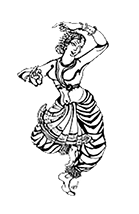
Origins & History
Bharatnatyam is a popular dance form of India.
This dance technique from South India comes from a land of ancient Hindu culture & traditions. The Puranas give us the meaning of Bha-ra-tha as a combination of Bhava (Expression), Raga (Melody) and Thala (Rythym).
This great dance form was handed down to us by the dance teachers called "Nattuwanars" and was performed in the temples of South India by the Devadasis or dancers dedicated to Gods. The technique has evolved over the centuries to become one of the most comprehensive dance forms in the world, combining Nrita or pure dance, Nritya or interpretative dance and Abhinaya of the highest order. It is by the effort of the Tanjore Quartet who created the Bharatanatya Programme as it is presented today. Bharatanatya can be performed as a Solo dance and dance dramas also.
It is believed that gods and goddesses pleaded Lord Brahma, the Creator of the Universe, to create a veda for the common man to understand. In keeping with this request Lord Brahma created the fifth veda, Natyaveda, which is an essence of the four vedas. He took pathya (words) from the Rigveda, abhinaya (gestures) from the Yajurveda, geet (music and chant) from the Samaveda and rasa (sentiment and emotions) from the Atharvaveda to form the Natyaveda.
After creating the Natyaveda, Lord Brahma gave the same to sage Bharata to popularise the veda on earth. Following the instructions of the lord, sage Bharata wrote the Natyashastra, the Science of Dramaturgy, a great comprehensive work on the science and technique of Indian drama, dance and music. It is believed that the dance form Bharatnatyam may have got its name from the great sage.
There is also another story which says that Goddess Parvathi taught this dance form to Usha, daughter of Banasura, a demon. Thus the divine dance form Bharatanatyam was introduced to mankind.
In Indian mythology, Lord Shiva is considered as the supreme lord of dance. This divine art form is performed by Lord Shiva & his wife Goddess Parvathi. The Dance performed by Lord Shiva is known as Tandava, which depicts his violent nature as the destructor of the universe. The tandava performed with joy is called Ananda Tandava and performed in a violent mood is called Rudra Tandava. Tandava has vigourous, brisk movements. The dance performed by Goddess Parvathi is known as Lasya, in which the movements are gentle, graceful and sometimes erotic. Some scholars call Lasya as the feminine version of Tandava.
The art form has definitely gone through lot of changes over the years. In olden days it was performed mostly by female artists. They were called Devadasis, who would perform in the temples. These devadasis were accomplished artists who would sing, dance, play many instruments. They were well versed in Sanskrit & other languages which helped them to interprete compositions which they would perform. But this tradition came to an end as the devadasis lost their position in society.
Then dance entered the royal courts. Here the artists called Rajanartakis, performed in the courts of kings who gave them shelter. Even these were accomplished artists like devadasis.
The next well-documented period of dance history is far more recent. In the first half of the 19th century the dance tradition was revitalized and defined anew through the contributions of four talented brothers (known today as the Tanjore Quartet): Chinniah, Sivanandam, Ponniah and Vadivelu. By coordinating their diverse talents, the four managed to organize all the basic dance movements of pure dance into a progressive series of lessons [adavu chapters]. Each adavu (basic unit of motion) was taught in systematic order and then combined with others to produce choreographed sequences based upon the rhythmic contour of a musical composition. In addition, the brothers composed new music specifically for the dance, and introduced a different sequence of items which integrated the various aspects of dance and music into a carefully coordinated, aesthetically sound progression. This infusion of creative energy marks the early 19th century as one of the most innovative periods in the history of Indian dance.
Even though Bharatanatyam has gone through lot of changes, it still has its roots deep into the religious and rich mythological heritage of India. In the modern day scenario it is performed by both male & female artists. Many learn as a hobby and some make it as a profession. Whether taken as a hobby or a profession it certainly needs lot of practice, concentration and dedication.
Nrutyashala School of Indian Classical and Folk Dance
777 N. Grove Road, Suite 113, Richardson, TX 75081 • 972-977-9765 • nrutyashala.school@gmail.com


